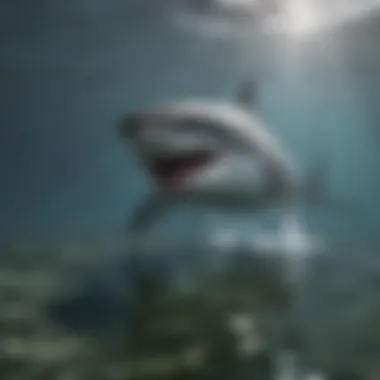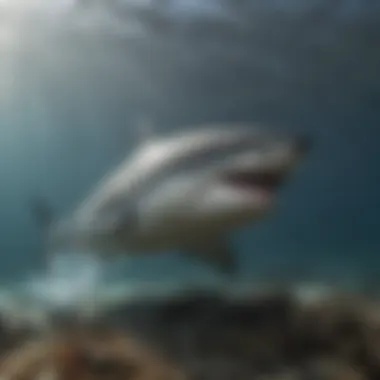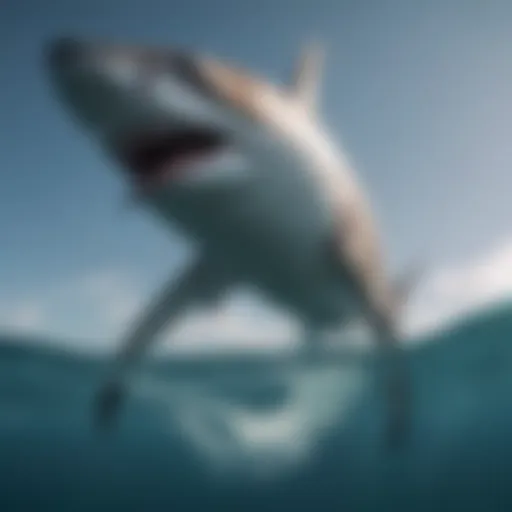Understanding Great White Sharks: Apex Predators of the Ocean


Nature Topic Overview
Great white sharks are among the most iconic creatures of the ocean. They are known for their impressive size and status as apex predators. These sharks play a crucial role in maintaining the balance of marine ecosystems. Understanding them is important for appreciating ocean life and recognizing the threats they face.
These sharks can grow up to 20 feet long and weigh over 2,000 pounds. They have a distinct white underbelly with a gray top, allowing them to camouflage while hunting. Their hunting techniques are fascinating and are key to their survival. These include ambushing prey from below and using their keen sense of smell.
As apex predators, great white sharks help control the populations of other marine animals. This regulation is essential for a healthy ecosystem. For instance, by preying on sick or weak animals, they ensure the overall health of species within their environment.
Fun Facts and Trivia
- Cool Hunting Skills: Great white sharks can detect a drop of blood in over a million drops of water.
- Speedy Swimmers: They can swim at speeds of up to 25 miles per hour in short bursts.
- Longevity: They can live for over 70 years in the wild.
- Unique Teeth: Their teeth are triangular and can be more than three inches long, perfect for grasping and tearing.
"Understanding great white sharks allows us to appreciate the complex dynamics of our oceans."
Wildlife Explorations
Great white sharks share their habitat with various marine species. Some of these include seals, sea lions, and smaller fish that form their diet. Other notable marine animals include whales and dolphins, which also play significant parts in ocean ecosystems.
Related Species
- Tiger Sharks: Known for their broad diet, they also interact with similar prey.
- Hammerhead Sharks: Distinct for their unique head shape, they often hunt in schools.
These animals are equally vital for maintaining ecological balance.
Environmental Awareness
Understanding the challenges that great white sharks face is important. They are threatened by overfishing, habitat loss, and pollution. It is crucial to promote conservation efforts aimed at protecting sharks and their environments.
Conservation Tips for Kids
- Learn and Share: Educate friends about the importance of sharks.
- Support Local Conservation: Join local conservation groups focused on marine life.
- Reduce Plastic Waste: Participate in beach clean-ups to protect oceans from litter.
DIY Nature Activities
Engaging in hands-on activities can deepen understanding of these magnificent creatures. Here are some simple and fun ideas:
Create a Shark Habitat
- Collect materials like cardboard, markers, and stickers.
- Design your own ocean scene, including great white sharks and other marine animals.
- Display the habitat to share with family or friends.
Shark Tracking Game
- Materials Needed: Paper, markers, and perhaps a map of the ocean.
- Instructions: Create a map showing different areas where sharks might be found. Draw paths for the sharks, and try to follow their routes on the map.
These activities can spark curiosity and encourage further exploration of marine life.
Prelude to Great White Sharks
Great white sharks are among the most remarkable creatures in the ocean. Understanding their role within marine ecosystems is crucial for comprehending the delicate balance of these environments. This section lays the foundation for discussing their biology, behavior, and the challenges they face today.
In this article, we will explore various aspects of great white sharks that contribute to their status as apex predators. These include their physical adaptations, hunting techniques, and interactions with other species. Moreover, we will consider environmental threats and conservation efforts aimed at ensuring the survival of these magnificent animals.


Overview of the Species
Great white sharks, scientifically known as Carcharodon carcharias, are large predatory fish found in coastal and offshore waters around the world. They can grow up to 20 feet long and weigh over 4,000 pounds. These sharks are easily recognizable by their conical snouts, sharp teeth, and a distinctive color pattern, which consists of a white underside and a grey upper body. This coloration serves as effective camouflage, allowing them to ambush prey from below.
The great white shark's diet primarily includes seals, fish, and even smaller sharks. As apex predators, they maintain the balance of the marine food web. Their hunting habits and preference for certain prey species are influenced by various factors, including availability and size of the prey.
Moreover, great white sharks are known for their unique social behavior. They often exhibit complex interactions with each other, especially during mating season and when competing for food. Understanding these dynamics adds depth to our comprehension of their ecological role.
Habitat and Distribution
Great white sharks are widely distributed in temperate and subtropical waters. They can be found in regions such as the Pacific Ocean, particularly near California and Hawaii, as well as the Atlantic Ocean near the coasts of South Africa and Australia. Their presence is notably significant in areas with abundant prey, like seal colonies, where they hunt for food.
They tend to inhabit coastal waters but can also be found in deep ocean contexts. Their migration patterns are influenced by environmental factors and prey availability, leading them to travel large distances throughout their lives.
Here are some key points about great white shark habitats:
- Coastal Regions: Often spotted near the shorelines, particularly in warmer months.
- Open Ocean: Sometimes migrate far from coastal areas, where deep water exists.
- Nursery Grounds: Young sharks often return to shallow waters where they can grow safely from predators.
Understanding the habitat preferences of great white sharks is vital for conservationists. It helps in creating effective protection measures for their populations and the ecosystems they inhabit.
Anatomy of the Great White Shark
The anatomy of the great white shark is vital for understanding its role in the ocean ecosystem. Each physical feature contributes to its success as an apex predator. From its powerful build to its specialized organs, the great white shark is a finely-tuned creature, capable of thriving in various marine environments. Understanding these anatomical details not only fascinates but also underscores the importance of conservation efforts aimed at protecting such remarkable animals.
Physical Characteristics
Great white sharks are known for their distinctive physical traits. They can grow up to 20 feet long and weigh over 2,000 pounds. Their bodies are sleek and streamlined, which allows them to swim efficiently. The dorsal side is typically grayish, while the ventral side is white. This color pattern, known as countershading, helps them blend into their surroundings.
The jaws of the great white are particularly notable. They can contain about 300 serrated teeth, arranged in several rows. These teeth are not only sharp but also designed to keep hold of slippery prey.
Some other key physical aspects include:
- Fins: The pectoral fins provide stability while swimming, and the powerful tail fin propels them forward.
- Skin: Their skin is covered with dermal denticles, which reduce drag as they move through water.
- Size and Weight: Females are usually larger than males, which is common in many shark species.
Understanding these characteristics helps us appreciate how the great white shark has adapted to its predatory lifestyle and why its physical features are crucial for survival in the ocean.
Sensory Adaptations
Great white sharks possess several sensory adaptations that make them highly effective hunters. These adaptations allow them to perceive their environment in ways that are essential for locating and capturing prey.
- Lateral Line System: This system is sensitive to vibrations in water, helping sharks detect movement from potential prey.
- Electroreception: Great whites have specialized organs called Ampullae of Lorenzini which allow them to sense electrical signals produced by other animals. This is particularly useful when hunting in darker waters.
- Vision: Their eyes are adapted for low light environments. This adaptation gives them an advantage during dawn and dusk, when many prey species are active.
- Smell: Sharks are known for their incredible sense of smell. They can detect blood in very small concentrations, making them highly effective scavengers as well as hunters.
These sensory adaptations are fundamental in ensuring their role as predators. They enable the great white shark to navigate complex underwater environments, find food, and avoid dangers. Understanding these adaptations enhances our knowledge about their behavior and ecological role in maintaining a balanced ocean ecosystem.
Great White Shark as an Apex Predator
Great white sharks are crucial in the balance of marine ecosystems. As apex predators, they sit at the top of the food chain. This position enables them to regulate populations of other marine species, which helps to maintain a healthy ecological balance. Their role in the ocean goes beyond mere hunting; it is about control and sustainability within their environment. Understanding their behavior and interactions provides insights into the health of the entire ocean system.
Role in the Marine Food Web
In the marine food web, great white sharks have a vital function. They primarily feed on marine mammals, fish, and occasionally sea turtles. By preying on these species, they help to control their populations. This prevents overpopulation, which can lead to depletion of resources in the ocean. For example, when great whites hunt seals, it helps keep seal populations in check, enabling a balanced ecosystem. This regulation allows other species to thrive and promotes biodiversity.


Moreover, the presence of great white sharks signals a robust ocean environment. When their populations dwindle, it could indicate underlying issues such as pollution or overfishing. Thus, they serve as indicators of ecosystem health, showing how human activities can impact the ocean.
Prey Selection and Hunting Strategies
Great white sharks exhibit fascinating hunting strategies that enhance their effectiveness as predators. They rely on a mix of ambush tactics and strategic questioning of their prey. Their preferred method often involves swimming beneath their prey and launching a powerful, surprise attack. They use their speed and strength to catch fast-moving prey.
These sharks have a varied prey selection. While seals are significant in their diet, they also consume fish like tuna and even smaller sharks. Their ability to adapt their hunting techniques to different prey types displays their intelligence and predatory efficiency.
Understanding these hunting strategies can help inform conservation efforts. By recognizing which species great whites target, researchers can better assess the health of those prey populations and the overall marine ecosystem.
The Impact of Predation
The impact of predation by great white sharks extends far beyond individual species. Their predatory behavior influences entire ecosystems. By keeping certain prey populations in check, they allow for a diverse array of marine life.
This influence creates complex interactions within the marine community. If great whites were removed from the environment, their prey might become overly abundant. This overabundance could lead to overgrazing of kelp forests or coral reefs, which are vital habitats for numerous marine organisms. Consequently, the absence of great white sharks could trigger a domino effect, leading to loss of biodiversity and unhealthy ecosystems.
"The role of apex predators like great white sharks is essential in fostering healthy ecosystems. Their hunting behavior shapes the distribution and abundance of many species in the ocean."
More information can be found at Wikipedia or Britannica.
Great White Shark Behavior
Understanding the behavior of great white sharks is essential to grasping their impact on marine ecosystems. These behaviors reveal not just the predatory instincts of these sharks, but also their social interactions and migration habits. Such insight can aid in conservation efforts and help mitigate human impacts on their populations.
Social Behavior and Group Dynamics
Great white sharks are often perceived as solitary hunters. However, recent research has shown that their social behavior is more complex than previously thought. Social structures can sometimes be observed among these sharks, particularly during mating or in areas where food is abundant.
- Aggregation: Great white sharks can gather in specific locations where food sources are plentiful. During these times, they exhibit a range of social interactions that can include play and even social hierarchies.
- Interactions: Observers noted that sharks can show interest in one another, which might indicate a social structure. This behavior suggests that they communicate or react to each other's presence, which is essential for survival.
- Territoriality: While generally not territorial, there are instances where great white sharks protect their feeding grounds. Dominant individuals may assert their presence to deter others from intruding.
These social dynamics are critical to understanding their behavior as apex predators. They influence hunting success and assist in the survival of individual sharks through learned behaviors and communication.
Migration Patterns
Migration patterns of great white sharks are yet another fascinating aspect of their behavior. These patterns reflect the sharks' responses to environmental changes and prey availability.
- Seasonal Migration: Great white sharks are known to migrate seasonally. In warmer months, they may move to coastal areas for breeding and feeding, while during colder months, they might venture into deeper waters.
- Long Distances: Some great white sharks travel exceptional distances, often exceeding thousands of miles. Tracking studies have revealed these migratory routes, which often link feeding grounds and breeding areas.
- Navigation Techniques: The mechanisms that drive these migrations are still not entirely understood. Researchers believe that sharks may use a combination of environmental cues and possibly even the Earth's magnetic fields to navigate during their long travels.
Understanding the behavior of great white sharks, including their social dynamics and migration patterns, is essential. It enhances knowledge of their ecological role while also being crucial for effective conservation efforts.
Threats to Great White Sharks
Great white sharks are emblematic of the ocean's vibrant ecosystems. Their existence is crucial, and understanding the threats they face underlines their ecological role. These threats encompass human activities, environmental changes, and their far-reaching impact on marine health and biodiversity.
Human Impact and Conservation Status
Human activities pose the most significant risk to great white sharks. Overfishing, accidental catch in fishing gear, and habitat destruction diminish shark populations. Often, they are caught unintentionally while targeting other fish species. This form of fishing, known as bycatch, is dangerous for sharks and other marine creatures.
Many countries have recognized the need for conservation. Various laws protect great white sharks from exploitation. These regulations include bans on shark finning and measures to regulate fishing gear. Yet, enforcement varies widely across regions, often influenced by local economic conditions and cultural attitudes toward sharks.
Conservation efforts, such as those promoted by organizations like the Shark Trust, call for increased awareness and protection measures. By engaging fishermen, policymakers, and the public, conservation groups work to ensure the survival of this critical species.


Environmental Changes and Challenges
Environmental changes also threaten great white sharks. Climate change is altering sea temperatures and currents, impacting the shark's migratory patterns and prey availability. As ocean waters warm, changes in marine species distribution can create food shortages for these apex predators, leading to population decline.
Moreover, pollution poses a severe risk. Plastics, chemicals, and other pollutants enter the ocean and disrupt marine life. When great white sharks ingest toxic materials, it can lead to health complications or reproductive issues, further threatening their survival.
"The health of great white sharks is a reflection of the ocean's overall health. Protecting them means protecting the whole ecosystem."
Addressing these threats requires a concerted effort. Public awareness campaigns, alongside effective legislation, are essential. By promoting sustainable fishing practices and minimizing ocean pollution, we can help safeguard the future of great white sharks and maintain the balance within our oceans.
Conservation Efforts and Future Outlook
Conservation efforts play a crucial role in ensuring the survival of great white sharks and the overall health of ocean ecosystems. These efforts are designed to protect these magnificent creatures from various threats they face, particularly those caused by human activities. Without proper conservation, great white sharks could decline, which would have a significant impact on marine biodiversity and ecological balance.
Current Conservation Programs
Several organizations and government bodies are actively working on conservation programs for great white sharks. Here are some important initiatives:
- Marine Protected Areas (MPAs): Many regions have established MPAs where fishing is limited. These areas serve as safe havens for great white sharks, allowing them to breed and hunt without interference from human activities.
- Research and Monitoring Programs: Through tracking and tagging, researchers gather data on shark movements and behaviors. Programs like those run by Ocearch provide critical information that helps in understanding their habitats and migration patterns.
- Public Outreach Campaigns: Many organizations focus on educating communities about the importance of great white sharks. For example, shark conservation groups often engage with schools to teach young people about marine life and the threats sharks face.
These conservation programs are essential not only for the protection of great white sharks but also for fostering a greater appreciation for our oceans.
Importance of Research and Public Awareness
Research is key in the fight to protect great white sharks. It helps gather vital information on their behaviors, habitats, and the impact of environmental changes. Understanding these aspects is necessary to develop effective conservation strategies. Essential factors include:
- Ecosystem Interactions: Research helps us understand how great white sharks interact with different species. This knowledge is important in managing marine ecosystems effectively.
- Behavioral Studies: Studying the predatory behavior of great white sharks provides insights into their ecological role. Studies show how their predation affects the populations of other marine animals and helps keep the ecosystem balanced.
Public awareness is equally critical. When communities understand why great white sharks matter to the ocean, they are more likely to support conservation initiatives. Engaging local populations in discussions about marine health can lead to more informed decisions regarding marine life.
"The survival of great white sharks ties directly to our understanding and appreciation of the ocean's ecosystem."
Conservation efforts depend not just on regulations and protected areas but also on our collective will to preserve the ocean environment. Through education, informed research, and active participation in conservation efforts, we pave the way for a better future for great white sharks.
By focusing on these aspects, we can foster a sustainable perspective for the future of great white sharks and, by extension, the health of our oceans.
Closure
The conclusion of this article serves to emphasize the critical role that great white sharks play in the marine ecosystem. It summarizes the insights provided throughout the piece, focusing on their ecological importance, unique behaviors, and the threats they currently face.
The Ecological Importance of Great White Sharks
Great white sharks are not just fierce predators; they maintain the balance of marine life. As apex predators, they help regulate populations of various species, including seals and smaller fish. By ensuring that these populations remain stable, they support a diverse marine environment. This balance is essential for the health of the ocean, which, in turn, affects global ecosystems. Without great whites, certain species could proliferate unchecked, leading to declines in biodiversity.
Research indicates that their presence in an area can indicate a healthy ocean environment. When great whites thrive, it often correlates with a rich and diverse marine ecosystem.
"Great white sharks give structure to the communities of marine species they interact with. Their absence disrupts the entire food web."
Call for Sustainable Practices
To protect these vital creatures, a call for sustainable practices is necessary. It is crucial to minimize human impact on sharks and their habitats. Overfishing, pollution, and climate change significantly threaten their populations.
Efforts can include:
- Implementing stricter fishing regulations to prevent bycatch.
- Reducing ocean pollution to improve marine health.
- Supporting conservation programs that promote shark education and research.
Everyone has a part to play in maintaining the balance of our oceans. Awareness and action can lead to policies that benefit great whites and marine life as a whole. By adopting sustainable practices, we can help secure the future of these magnificent sharks and the vital role they fulfill in their ecosystems.


Unveiling the Enigmatic Traits of Sharks: Evolution, Predatory Behavior, and Ecological Significance





